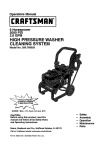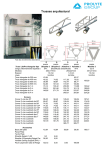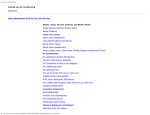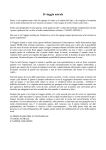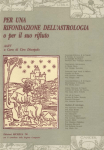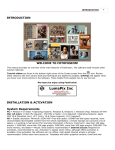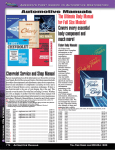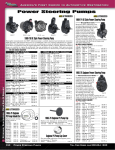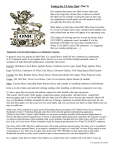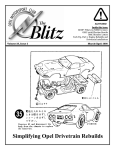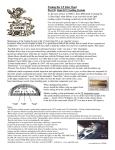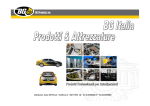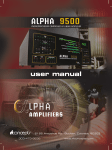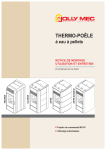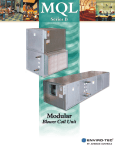Download Prototype E-Blitz Ver. 2
Transcript
ry An 35t ni h ve rs a Inside this issue: Retrospective: Road & Track ‘s Coverage of Opel 1968 1968--1975 Volume E, Issue 02B Digital Prototype #2B, 2015 ? The “Missing Opel Book” Perhaps the best Opel books in terms of page count and value are the "Portfolio" paperbacks, that include original drive tests and other coverage drawn from numerous magazine articles published many years ago. Portions of those were re-printed in older Opel Club issues, but contrary to an impression that may have been given, they do not contain all there is to know! Recently a news article appeared about unpublished original auto magazine notes, photos, and other materials, which were being made available for public inspection at a university archive. This brought back memories in particular of Opel-related coverage from Road and Track magazine, with a focus on the peak US-export Opel era of 1968-1975. Unfortunately, inquiries to the archive revealed that no Opel-related materials apparently survived to make it through processing by staff for this special collection. This compounds an apparent slight by existing publishers, who compiled R&T articles for numerous other makes, but apparently did not find their Opel coverage worthy of a book edition! What we did get, was some brief internal correspondence concerning advertising rates in the early 1970's, combined with a analysis of overlaps of editorial coverage with ads (for several product manufacturers, including Opel). The actual documents were heavily restricted from use, per terms that are commonly applied to vintage materials by archives nowadays. (Some of the terms of those restrictions, are on a back page, for your information and possible amusement). This opened a narrow legal window, for a critical re-evaluation of a sampling of ads and editorial notes concerning Opel cars, as well as vintage aftermarket products made for them, within exclusions provided by present-day copyright statutes for materials distributed without cost online. So we revisited a stack of old-time R&T issues, capturing lots of writing and “eye-candy” from works of teams of automotive industry professionals, to give our readers a glimpse of a superior level of quality that a “free” online “E-Blitz” could provide (versus overpriced & money-losing print). R&T has its own unique and distinguished history since it's late 1940's inception, as one editor put it "...we pride ourselves not only giving you the facts, but also in presenting them to you in a manner that has some literary quality.." A bit more about the background of the time frame we’re focusing on here, appears on a following page (after the editorial). “Why not ‘Car and Driver”? GM’s ire was aroused, by C&D’s evaluation of the then-new 1968 Kadett wagon, amongst the background of an automotive junkyard! In response, GM limited their cooperation with the magazine, including a withdrawal of advertising. Opelclub.com ©2015 Note: Marketing #101 Why advertise it (if it can’t even be spelled correctly)? Editorial What's an "E-Blitz"? It's a new OMC prototype that's presently in development. Within this format, "supplemental" coverage that for various reasons doesn't make it into the print-version OMC Blitz can appear (at minimal, if any, additional cost to the club itself). Why is there an E-Blitz? Differing circumstances motivated this document. The first goal was getting OMC back to a uniform branding situation where a newsletter could be obtained from the official website for the Opel Motorsport Club (as was done here, exclusively, for years). It was important to restore that function to resolve a situation where recent publications have been diverted elsewhere. Another goal was to revisit the editorial standards of "old" Blitz issues. This innovation allows OMC to revive its long-standing function of providing information such as tech notes that Opel owners can rely on (which stands in contrast to other venues, where less-reliable marketing-based messages have been allowed to proliferate). Budgetary Impact ? A net cost of $0.00 (zero) from OMC’s treasury was required for this publication. A related benefit is a better positioning of the image of OMC, through this method of providing standardized sample downloads in front of the “paywall” (for easier comparison to messages that include mis-characterizations about OMC—which seem to be caught in current “groupthink” tendencies on some social media). Finally, we hoped this provision of a second full-length 2015 "prototype" would help to make up the balance of unpublished print-version Blitzes (to members who paid for bi-monthlies in 2014 but are scheduled to receive quarterlies in 2015). Some of OMC's old-timers feel that regardless of circumstances that we should always act with “goodwill” (including keeping our word), in accordance with Article II of OMC’s By-Laws. OMC 2015 What will happen next? Other Coverage ? While this document is formatted so pages can be printed using any basic computer, at this time any dedicated publication or archival functions will require further technical development (that will have to be worked out, under the authority of the OMC Webmaster). Those looking for announcements and details of OMC Club events, are referred to the print-version OMC Blitz. In the meantime, please enjoy OMC’s retrospective of “The Missing Opel Book” in the following pages. The Times of Road & Track Automotive manufacturing and production was the main driver of economic growth for over a half-century within the USA. By the 1950’s it wasn’t unusual to hear repetitions of the statement “what’s good for General Motors is good for America.” That changed by the 1970’s, as per Hemming’s, “the big-bore American muscle car was strangled by emissions and fuel crises, forcing innumerable buyers to look into smaller cars for driving pleasure.” To revisit that context we’re summarizing concerns reported by Road & Track in the peak 1968-1975 Opel era. Urban Air Quality (1970) Government Intervention Numerous regulations were somewhat arbitrarily enforced in the late 1960’s-early 1970’s, with mandates for engines that would run on unleaded fuel, for exhaust emissions within tight limits, and for improved safety features. In the case of US-export Opels, GM engineers simply de-tuned the motor output through alterations of the pistons for a lower compression ratio and a re-curve of the distributor for less advanced ignition timing (starting with 1971 models). Other additions included emission-control hardware and some rather primitive and confining seat belt configurations. Cost Control These came from different factors. Increasing damage frequency and accident-payout amounts attributed to the “musclecar” sector led to readjustments in insurance coverage and cost by 1970. Import Costs/Exchange Rates This was compounded by changes in the exchange rates between a falling US dollar and a resurgent Deutschmark from 1970-1975, which raised the costs of importing German-built sedans. Other Issues As a Newport Beach-based periodical whose interests didn’t end at the US border, R&T was particularly well-situated to record trends and changes motivating import car sales, during the 1968-1975 peak US Opel era. Imports as a sector of new US car sales grew from 11% in 1970 to 16% in 1971 (42% share of the Southern California market), and this trend exploded when gasoline became more expensive (when you could find it). Fuel Crises (1973, 1979) Opels did enjoy a brief resurgence in Spring 1974, when Buick shifted marketing in its favor and buyers flocked back to the dealerships seeking higher-efficiency 20mpg sedans. But shoppers reportedly were redirected when a smaller Buick was introduced later that year, and as a result the Opel marquee surrendered considerable market share. Ultimately the German-made Opels dropped from the Number 2 import brand in 1968 (at just under 100,000 sales) to somewhere way behind Toyota and Datsun by 1975 (with U.S. sales reportedly numbering about 15,000 for its final imported model). The Kadett Years (1967-1970) As the #2 selling import car in the middle 1960’s (second only to Volkswagen), Road & Track certainly took note of the Opel line. We start here with the “modern era” Kadett B series, which received feature coverage from 1967-1970. Road Test: Kadett Rallye 1.1L (October 1967) R&T’s writers were pleased with the responsiveness of the 1967 Kadett Rallye, even praising how its tiny 1.1 liter motor responded smoothly up to a high-revving 4500rpms’s in typical driving. “The Opel invites brisk driving, even on brief acquaintance...the driver’s seating position is high and commanding so that the all-round view combines with the extremely responsive steering to inspire confidence even in close-quarter maneuvering…” On the downside, “neither is it altogether happy on any but the smoothest roads, as the stiff-kneed suspension tends to get hoppy on uneven surfaces”. Although the Kadett was praised as being “more fun to drive in short-haul traffic conditions or where quick maneuvering is required...a zippy little bucket that would be fun to have for a second car,” R&T also trashed its styling (they didn’t like the matte black hood because it required washing!) and recommended purchase of a 1500cc Ford Cortina GT over it. Their editorial stance, may have been influenced by their terming of this Kadett as a “captive import,” reminding the public of the “orphan” status of owners of Opels formerly sold from 1957 through 1962 (which suffered when GM dealer support was temporarily withdrawn circa 1963). Now forty-eight years later this is critical, as part availability for a unique ‘67 model is hit-or-miss for many items. Note: This article was reprinted in the 1/1994 Blitz. Road Test: Kadett Rallye 1.9L (March 1968) “Bigger engine and bigger performance for only a little more money” is how this profile opened. While attempting to once again critique General Motors, R&T found itself praising the many available model variations (fastback, 2 door sedan, coupe and wagon**), option packages like the LS, and choices of the 1.1, 1.5 or 1.9 liter engine versions, that came with the 1968 model year Kadett. “Super Sleeper” is how they described their test-version Rallye, which came with the 1.9 and 3.67:1 rear axle ratio gears. “The 1.9 spins a rear wheel almost as avidly as an American V-8 getting off the line” is how they put it, leading them to term it as a “mini-musclecar”.** They also liked the effective disc brakes, and noted “a lot of Detroit-style pizzazz...with its look-at-me stripes, hubcapless wheels, and so forth.” On the downside, on models with the 1.9L the weight distribution of 56/44 front/rear caused a general heaviness and plowing in turns. Drivers also found the car very noisy, due to insufficient soundproofing of the interior from sounds of the engine and heater fan as well as air resistance at the high roofline. Their final statement, however, is reason enough to question advice found in auto magazines. “We’d recommend that anyone seriously considering buying the car try the 1.5 liter version. It might not be so noisy, and it’ll still be pretty fast.” (Subsequent driving, however, revealed the 1.5L to be an underperformer, and in fact rival magazine Car & Driver emphasized the point, by accompanying their 1968 Kadett 1.5L drive tests with photos of the car taken in a junkyard!) **Notes: The earliest 1.9L engines had unique features that raised compression and output, compared to later designs. The 1968 Kadett wagon was also included in a comparison test with other import wagon models, later in the year. The Opel Kadett Letters Back in the day, well before any Opel Clubs existed here, if you had a technical question that went beyond what your local Buick dealer would perform under a factory warranty, you were asked to: Type a letter, mail it to a magazine, wait a few months, and hope your question would receive a (correct) answer that would make it into print. "Off Mit Der Air Pump" How do I disable the air pump on my Opel 1.9 Kadett for autocrosses, etc., without upsetting engine performance? W.J. P. of Monroeville, PA (May 1968) Opel A.I.R. pump Kadett Rallye R&T Reply: You may have a confused idea of what the air pump is all about. The pump itself can be disconnected with no effect on engine operation, as long as the plumbing to the port nozzles is securely plugged off (there is a one-way valve there for the purpose but you shouldn't depend on it). But the pump itself only uses about 1/2 hp, and very rarely does the combustion in the exhaust manifold create a back pressure problem. What does rob horsepower - if indeed anything does on your particular engine would be the leanness of the carburetion and the odd distributor curve at low speeds. To get away from these you'd have to go to richer jetting and to the curve used on domestic production of 1.9 liter engines - or cook up your own jetting and curve. Also this engine has a real windmill of a cooling fan, which uses a bit of power. "Autocrossing Opel Rallye" Your June Suspension Supplement was very informative. But I have some specific problems of my own. If I'm going to continue competing with those Bavarian Miraculous Wonders in gymkhanas, my Opel Rallye 1.9's handling must be tamed. There are, as you know, few suspension modifications available. Any tips for making the car competitive? Fred J. of Gloucester, MA (September 1970) R&T Reply: You're in luck. Warren P., of Ecurie Mahout Opel Racing (Corapolis, PA) has the following on his 1.9 Rallye and has won 23 firsts and three seconds with it: (1) (2) (3) (4) (5) (6) (7) (8) (9) (10) Monroe Load Leveler shocks, FL-257, on the front 1966-69 Falcon station-wagon shocks for the rear (!) X127.5 primary jet and X165 (#51 drill) secondary jet for carburetor Opel Limited Slip differential, 3.67:1 or 3.44:1 Tennis balls wrapped in two layers of fabric tape and wired between frame and lower a-arms, to reduce front body roll (!!) Dodge-Plymouth air filter from 318 V-8 Bosch W225T7 spark plugs Transistor ignition Air pump disconnected, retard vacuum line plugged and diaphragm vented (on models where applicable) Goodyear 4.50/7.50-13 Sports Car Special tires Racing Graphic c/o Repco Reader W.P. emphasizes that rather than recommending these changes, he's simply saying that he has had good luck with them. He has beaten BMW's, Fiats, VW's, Lotus, Cortinas and Minis (except in the rain). He also says to make sure the throttle plates are fully vertical when the accelerator pedal is on the floor. Racer’s Tip: Throttle Linkage Adjustment In his “Autocrossing Opel Rallye” notes from 1970, Racer Warren P. of Ecurie Mahout Opel Racing reminded his readers to “make sure the throttle plates are fully vertical when the accelerator pedal is on the floor.” An important yet often-overlooked maintenance item, this topic now needs an update, as hardware variations on aftermarket carburetors affect the throttle plate operation as well. As there are more surviving GT’s than Kadetts nowadays, we’re using its (similar) mechanical linkage system for an example. (Manta/1900 series operate differently, with a cabled system). Throttle Operation Preparation (1) Make sure your throttle linkage is fully intact and functional, by referring to the diagram below. (2) Check to verify that the 2 throttle grommets are installed and intact at the firewall brackets. (3) Use a screwdriver to fully tighten the 3 screws that secure the gas pedal. Actual rotation varies by model, from about 65 degrees up to about 85 degrees Gas Pedal Screws Original Solex Lever Pivot Rotation Test (1) Prop up the hood. (2) Have a friend step on the gas pedal and hold it fully to the floor. (3) While the throttle is fully deployed, grab the throttle lever on the carburetor itself, and see if you can rotate it any further. (4) If additional rotation is possible, you need to adjust the throttle linkage until you can verify you have “full rotation” at the carb. Aftermarket Lever Angle variations at pivot points can also affect 5 or more degrees of rotation Throttle Linkage Adjustment** Abstract View (1) Locate adjustment rod at pedal end (see figure below) (2) Carefully detach clip and set it aside safely. (3) Rotate attaching pin lower on the rod. Try rotating the pin downward about 10 threads at a time. In some cases, the pin may have to be “maxed out” at about 3-5 threads from the bottom of the rod. (4) Reattach clip. (5) Recheck your carburetor for full-throttle operation. Carb Idle NonRotation Rotation Full Carb Throttle **Note: This procedure only applies to manual-transmission Opels. Auto Transmission use a different design adjustment rod, which has an external spring to protect the detent cable from breaking. (R grommet) Pivot Any under-rotation of throttle linkage, represents “missing” power potential (L grommet) (Clip) (spring) Opelclub.com ©2015 (Throttle Linkage) (Pedal End) Adjusting Attaching Pin Downward The Opel GT (1968-1973) R&T noted in June 1968 that the “sporting image” continues to be very “in” at that time, and the overall trend was towards larger engines, chrome flashing, wooden-appearing steering wheels and “GT” lettering. All these applied to Opel’s newest model that year. R&T’s judgments withstanding, the US-export version Opel GT never got a truly fair evaluation, largely because GM de-tuned its production-version engines and deleted its anti-sway bars. Opel GT, original Prototype version, 1965 "Opel GT" (Dec 1968) "Production version of a show car loses something in the translation" Road & Track's initial look at the production model Opel GT largely focused on changes to the its look (from the initial prototype that was displayed at the Frankfurt Auto Show in 1965). On the upside, they noted its "efficient aerodynamic shape," rotating headlights, doors that extended to the roofline, and interior features like a padded dash and high seat backs. Criticism included comparisons to the initial prototype, which was "longer and smoother" (Note: This article was reprinted in the Brookland's "Portfolio" series) "1.9 Opel GT" (June 1969) "Not bad but not up to expectations" Opel GT, as seen in “Get Smart,” 1969 Road & Track's road test of the initial production version GT was largely positive but also featured some reservations. Starting with mention of Opel's pre-WWI racing history, it was described as "essentially a Rallye Kadett living in a new set of clothes" and "the sports-car equivalent of the Kadett". Compliments extended to the "generous torque" and "excellent gearbox" of the 1.9 liter 4-speed drivetrain, with a top speed of 113mph and fuel economy at 27.5 miles per US gallon, and to the original configuration of disc/drum brakes which made a good impression. R&T also noted that while the steering was light and "really feels good," the handling of the US-version chassis (which deleted the Euro-versions' sway bars) was "at best mediocre". (This is no surprise to present-day GT owners, who have found it necessary to install upgrades like poly bushings and other chassis stiffeners like sway bars, to control wheel lift and restore a sports-car road feel). The body was "commendably rigid and free of rattles," the driving position and access to levers and controls "just where we like them" was also summarized in the statement that "all things considered we feel the GT's interior is rather nice and attractive." In conclusion, R&T noted that its mechanicals weren't exotic or unfamiliar, and that "there's a Buick dealer in nearly every village" in case service was required. (Note: This article was reprinted in the Brookland's "Portfolio" series) "5 GT Cars" (July 1971) "Comparing the Datsun 240Z, Fiat 124 Sports, Opel GT, MGB GT and Triumph GT-6: A closer contest than we expected" For the first time an Opel GT made the cover of Road & Track. It was easy to overlook, among four other models (which R& T considered to be rivals in the $3500 sport-coupe price class). As only 20% of the focus of this article, comments regarding the Opel GT were brief. Although the power cut of its 1971 model-year engine was noted, it was still "a crisp little package" Cover Photo, July 1971 issue that was "extremely well put together" with the best brakes and lightest weight and it returned the best fuel economy of the group. However, scoring based on a point system placed it 3rd, after the Dastun and Fiat, ahead of the MG and TR. R&T found it notable that the GT was the personal favorite of one reviewer, who nevertheless scored the Datsun higher. "Air Conditioning the Import" (June 1971) Road & Track started by noting that about 4.5 million cars (60% of US production) were equipped with a factory air conditioning system, but that comparatively few imports offered this option. One explanation was that engineers in European and Asian countries were unfamiliar with conditions found in US climates, including locations such as the desert Southwest. Taking up the slack was a number of aftermarket A/C unit producers, largely based in Texas and Florida. Two custom units for the Opel GT received mention (including a photo of the unique center console by ARA, and a description of a kit by 'Heatransfer' of San Antonio that fit behind the GT's seats), and other kits for Opel models were listed as available from Artic-Kar, DPD, Frigi-King and Frigette. A/C tested in June 1971 article Most details in this article were either based on general descriptions of air conditioning or on specific from road tests of units installed in a Toyota Corona, Volvo 164 or a Datsun 510. Some specific recommendations included inspection once per year and service once every 2 years (including replacement of the drier, R-12 type refrigerant, and any hoses as necessary). Note: This topic was explored at more length in the 1973 Opel Factory Service Manual (for GM type units) and the OMC Blitz of May 1995. "Back to Basics" (April 1973) "Track-testing nine showroom stock sports cars, the entire field in SCCA's newest class. Not a fair group, exactly, but certainly sporting" Once again the Opel GT was included in a comparative test, but this time it was just one in a field of nine (with the Fiat 124 Spider, MGB, MGB-GT, MG Midget, Porsche 914, Triumph GT6, Triumph Spitfire 1500, and the VW Karmann Ghia). The intention was to evaluate vehicles representative of the new class of "Showroom Stock" racers as eligible by the Sports Car Club of America (SCCA), and to have fun. The Opel placed well, first in race acceleration, second in top speed, lap times and braking distance, and in the middle of the field in lateral acceleration and skid pad times. With hindsight it should be noted that the 1973 GT tested has the weakest production-model engine (the trouble-prone 1973 motor) and the inferior US-export models suspension (without the sway bars provided on domestic European models). A deficiency of the Opel GT handling was described in these terms: "The Opel displayed a chronic problem: In a tight turn the inside rear wheel lifts, the engine rages, the tire spins and the car just sits there until the speed and the wheel both drop. The Opel didn't come out of turns fast then, because it couldn't power out." Above: Opel A/C dealer brochure, 1971 Below: Cover with Opel GT, April 1973 "Engine & Drive—Where Should They Go?" (July 1973) "In handling and traction tests of conventional, front-drive, mid-engine and rear-engine layouts in four similar cars, we found each to have its own advantages and disadvantages" The Opel GT made the cover, but again it was only one car amongst others in a technical evaluation. This article was a comparative test of multiple vehicles, as an attempt to answer a technical question of what drivetrain configuration was best for stability and handling. Varied surfaces were chosen for traction tests, including a skiing resort for low-speed driving in snow and the Ontario speedway for higher-speed tests. The Opel GT was selected an example of a conventional sports car in terms of a front engine coupled with rear-axle drive. Overall the tests were not conducted to determine a winner, but the Opel GT came in 2nd place and its "quick steering and the ability to hold a controlled power-on-drift" was noted. Where the GT came up short, such as in snow, it was attributed to its 55/45 front/rear weight distribution. Cover Photo, July 1973 issue The significance of these results is that they evidence the potential and need for power and handling upgrades on Opel GT, as the 1973 motor was the weakest original design, the 1973 chassis was the heaviest due to added safety reinforcements such as side-impact bars within the doors, and the removal of sway bars from US-export chassis left them vulnerable to wheel lift on turns. "The Opel's quick rack-and-pinion steering allowed the car to be precisely positioned from pylon to pylon, but working against it was body roll and weight transfer to the outside front wheel. This became very apparent at higher speeds as the nose-heavy Opel scrubbed off speed with each reversal of the steering wheel.. a bit of speed was scrubbed off by the heavy front end but by staying on the power we could drift the rear end out in a gentle curve. As the car approached the limit the tires started to squeal and the driver could sense the rear end starting to break traction. By letting up on the throttle slightly we could maintain the drift down the short straight and then reverse for a quick exit" noted Road & Track. Experiences of many GT owners since this article was published verifies a recommendation: For hard street driving (or track racing), to limit wheel lift, the Opel GT suspension requires installation of anti-sway bars (mounted properly to the chassis) Original GT suspension: Not up to R&T’s slalom tests The Opel GT Letters “Opel Suspension” In the July issue of R&T you discussed handling characteristics and anti-roll or stabilizer bars. You said the worst thing one could do to an oversteering car was to increase the rear roll stiffness by use of a larger rear stabilizer bar. In another suspension article rear recently, I found the opposite view expressed. The article said that if a car's center of gravity is located far forward of the neutral steer line you've got more understeer than you want. The article suggested raising the front roll center, adding front roll stiffness and some rear roll oversteer as possible ways to reduce the problem. If the car you're designing has its center of gravity some distance of aft of the neutral steer line you'll have an oversteer problem. Remedies the article mentioned included lowering the front roll center, adding rear roll stiffness and some rear roll understeer. Both views seem to be somewhat logical. Which is correct and why? I have an Opel GT which understeers...I understand that some of the aftermarket products (stabilizer bars) do not fit properly or limit suspension travel and I am hoping to avoid these problems. Finally, what is meant by tuning a suspension for radial or bias tires? For example, my 1971 Opel GT was sold with bias tires. Would tire wear or handling suffer with the use of radials? 1970’s design sway bars The writer here referred to known issues with “old school” aftermarket anti-sway bar designs. Product designers overlooked how the front rails on the GT underbody have a subtle irregularity, so “straight bars” wouldn’t center properly, causing cornering response to vary from one side relative to the other. Rear bar issues included mounting and clearance problems, resulting in a bind induced on the bar itself. Arthur B. of Davison, Michigan (1972) R&T Reply: Adding roll stiffness at the rear of a car increases oversteer while adding roll stiffness at the front increases understeer. The roll of a car body in a corner divides between the front and rear wheels approximately in proportion to the roll stiffness of the front and rear suspension. By varying roll stiffness front-to-rear the proportion of weight transfer carried by each end of the car can be varied. This is very important. If you restrict body roll, the force which is trying to cause the roll is has to go somewhere; it is converted to lateral force on the tires. Side forces are the cause of the tires running at slip angles. And when the slip angles become large enough the tires break away. Adding roll stiffness at the front therefore causes the front tires to run at higher slip angles, which generates understeer. Adding roll stiffness at the rear causes the rear tires to run at higher slip angles, which generates oversteer. Regardless of the amount of roll stiffness added, the total weight transfer on the car remains about the same; It's the proportion carried by the front and rear that is varied. Playing around with roll centers and roll over and understeer characteristics is fine if the car is still on paper, but difficult to achieve on an actual production car. However, raising the front roll center to reduce understeer is the wrong way to proceed. Raising the front roll center increases the amount of weight transfer to the outside front tire when cornering, which causes it to run at higher slip angles and promotes additional understeer. Designing rear roll oversteer into the suspension will aid in reducing understeer. A similar explanation holds for oversteer. Decreasing rear roll stiffness, raising the front roll center and designing some rear roll understeer into the rear suspension all will reduce oversteer characteristics... When a carmaker tunes a suspension for radial or bias tires it means, briefly, that the rubber bushings in the suspension, the rubber connections between the suspension and the body, and the shock absorbers have all been designed to reduce the little vibrations and harshness that different types of tires impart to a car at different speeds, and that the steering ratio may be quicker. You've got no worries with the installation of radials on your Opel GT. This car is fitted with radials in Europe and its suspension is already tuned for them. You should gain both better tire wear and better handling from the installation of radials. Opel GT Engine My 1971 Opel GT equipped with the 1.9 liter engine has a 7.6:1 compression ratio. I would like to raise it to 9.0:1 and change the carburetion along with the exhaust system. The bore, stroke and displacement are the same as the 1969 engine, which was 9.0:1. Can you tell me how to raise the compression back to normal or connect me with someone who knows Opels? Opel mechanics don't like my questions and other mechanics don't know what an Opel is! U.S. Opel Pistons Left: “Early” 9.0:1 hi-comp. type Right: “Later” 7.6:1 low-comp. type Craig S. of Severn, Maryland (1972) R&T Reply: The advice from our local expert is not to touch the head until you check the ignition and carburetion. You should have a total advance (vacuum plus centrifugal) of 35-44 degrees at 3500 rpm and preferably closer to 44 degrees for top performance. If the distributor work is done on a machine, all the numbers should be cut in half. At 1750 rpm you should have around 22 degrees total advance, 15 degrees centrifugal and 7 degrees vacuum. Any competent distributor man can make the necessary changes. Then go through the carburetor and make sure all the passages are clean and that the right size jets are fitted. And, most important, be sure the linkage is adjusted properly to allow the throttle plates to open fully. Distributor Variations Be aware that internal parts and specifications varied with GT engine designs of 1968-1973 Next step, if the engine is running excessively hot, is the installation of a cooler thermostat. This will improve volumetric efficiency. In most instances, according to our Opel man, your engine will really come alive with just these few inexpensive changes. However, if you are still not satisfied, it takes a change to 1969 or 1970 pistons rather than milling the head to et 9.0:1. The head can be milled, but no more than 0.035" and the increase in compression is only a few tenths of a point. Here are a few cautions if you decide to go ahead with the piston and/or head work. Solex Carburetor Many originals are now too worn for today’s driving conditions. Removing the head is problematic because the engine is set well back in the GT engine compartment. So you are going to need some special wrenches: The bolts at the back of the head are almost impossible to extract without them. Be very careful when removing the head that you don't lose the little "O" ring in the head gasket near the timing chain. If you forget to reinstall it, you'll wind up with a large oil leak. And when removing the timing gear sprocket, stuff a rag or a piece of plastic down the opening before you remove the three sprocket screws to prevent them from falling down into the lower recesses of the timing chain. Starting the engine with one of those little bolts lurking down there results in about $350 worth of repairs the first time the engine is cranked. The Opel engine is a cam-in-head type, so be very careful not to lay the head downflat on a bench when it is removed as some of the valves will be open and can bend very easily. Pistons, through the recommended procedure for raising the compression ratio, are relatively expensive to change. The engine will have to be pulled from the car, and this is a lot more expensive than just a few minor ignition and carburetor modifications. Comments: With the benefit of over 40 years of hindsight, R&T’s suggestions no longer exclusively apply. Opel distributors varied in mechanical and timing designs, and advance over 40 degrees is excessive for most engines. Carburetion approaches should include aftermarket applications (rather than service to an original Solex). While engine disassembly notes have merit, head milling is not advised and piston upgrade is now probably necessary. The Opel GT Letters "Optimists By Law" Reader T.L. McDonough, who complained of speedometer error in his two German cars (R&T December 1970), was not a victim of hanky-panky on the part of the manufacturers but of (German) government meddling with industry. It seems that they have a regulation which permits any auto manufactured in Germany up to a 10 percent "plus" error but absolutely no "minus" error at all. Needless to say, any car manufactured under this regulation is going to have an optimistic speedo! I can't imagine what the purpose of this regulation might be, unless it's a rather futile effort to keep speeds down to 110 mph on the Autobahn, but I remember where I first read about it. Richard von Frankenberg discussed I in Porsche's house journal, Christophorus, about ten years ago. Charles H. M. (Cheyenne, WY) April 1971 "Opel Tachometer" On the tachometer of my Opel GT there is written the abbreviation UPM under which there is written RPM. Obviously RPM is the abbreviation for "revolutions per minute" but what exactly does UPM stand for? I have noticed this same thing on my girlfriend's 914; this car is also fitted with VDO instruments. James C. (Jackson, MS) August 1973 Reply: UPM is the German abbreviation for revolutions per minute. In German the phrase is "Umdrehungen pro Minute" Despite attempts at re-styling the GT for 1974 (including 5mph crash-resistant bumpers, above), The end of the GT was announced in July 1973, and still speculated about in November of that year. The Manta/1900 Series Years (1971-1975) First noted at the Paris Salon of 1970 as GM’s answer to the Ford Capri, the writer dutifully asked “why they named I after a nasty sea creature like the manta ray I can’t think..” "Opel Rallye 1900" (Feb 1971) "They’ve changed and improved everything except the name" This article opened by stating “mention the Opel Rallye and everybody goes snicker, snicker. We all know about the Opel Rallye” referring to its prior Kadett version. It goes on to reassure us that the Rallye name was carried over to an entirely new car for 1971. Its styling was considered to be a success, and the new vehicle line was complemented on the handling of its updated suspension and the 1900 engine, although it also noted it was de-tuned for lower-octane unleaded fuel. Complaints focused on the seats, belts and interior vents. Note: This article was reprinted in OMC Blitz of Nov 1989 "Three Sporting Coupes" (Oct 1971) "Comparing the Opel Rallye 1900, Toyota Celica ST and Capri 2000" The Opel shared this issue’s cover with the Ford Capri and Toyota Celica ST. Inside, this article covered a new class of cars, sport coupes with 2+2 seating, which were easier for lower-income younger car buyers to operate and insure. The Opel was notes for great pleasure in handling, "sheer fun to drive" as it was said, and the engine was also complemented for being smooth and quiet and paired with a good-operating gearbox. "Road Tester’s Year" (Dec 1971) This year-end comparison of 25 autos that were tested in the magazine that year, that the Opel Rallye 1900 model received best results for steering. (The GT also rated rather well in that same category). "The Opel Menace" (1971) Odd chaps, the insurance people. While not wanting to give away all the findings of the Opel 1900 Rallye tested on page 98 of this issue, it is fair to say that the car has an improved suspension (and handling), better brakes and less power. And it looks nice, which might make you think it’s the car an insurance man would suggest when you come in to get coverage on your supercharged 427 Cobra. But shortly after we returned the test car, the local Buick man called, in panic. He'd just been notified that the 1900 Rallye has been declared a performance car for insurance purposes, meaning they charge more money for the insurance you must have. That of course raises the car's price and limits its market. After all the pious advertising the insurance people issue under the guise of favoring safer cars, this is how they repay a manufacturer who really has reduced performance, for the first time ever. The Opel Manta/1900 made the cover (only to be sandwiched between a Celica and a Capri) "Too Fast for Class" (August 1972) Opel racers and fans are due to learn a lesson in what Cadillac once called the penalties of leadership. When the SCCA announced the Showroom Stock Class many people looked at the list of cars eligible for the class and decided that the Opel 1900 coupe was the best choice. Some of these people rushed out and bought cars to race, and the Opel coupes won, time and again, at tracks across the country. One year is all Opel is going to get. The SCCA's Competition Board has been looking at the results of those races and has decided that a mistake was made. The Opel 57 coupe is the best in class, by too great a margin. Something has been done about that. As of June 1, two more Opel models, the 2- and 4-door sedans, have been added to the list of approved cars. And as of Jan 1., 1973, the coupe is no longer eligible. Congratulations to the club's governors are in order. The rules say that the SCCA can add or subtract from the list of eligible models any time it wishes to do so. And the competition board voted to simply drop the coupe from the list this year, which would have worked a hardship on those racers who decided that the coupe was the car to have, and who went out and got one. The Board of Governors, though, has taken the middle road. It wouldn't be fair to keep a model which is far faster than the competition and it wouldn't be fair to chop the guys whose judgment was better than the competition board's. So this year is Opel's, and next year things open up. Oh, things will open up because the sedans, although they use the same engine and basic drivetrain as the coupe, are three inches taller. More frontal area equals top speed. And I had planned to make some comment about the irony of the best car in class coming from a maker which can't advertise wins because racing is against that company's rules. But before I could do it the Buick dealers of Southern California were issuing giant posters telling of the Opel's track record. Salesmanship will find a way. "Opel 1900 Series Owner’s Survey” (Dec 1973) "Victim of the Captive Import Syndrome" This article was in some ways the most revealing of any coverage of the classic Opels from 1968 through 1975, as it was based on responses from actual owners of Opels rather than the workaday prose from R&T’s editorial writers. Opels were originally bought for their style or handling, then used for daily transportation, with 64% reported driving theirs “hard” (including 33% participating in competitions)! Buyer demographics were also noted: Most were young and educated, with a high percentage of students, and others in professional careers such as engineering or teaching. About 80% were then under 34 years of age. What was liked was their road response, comfort, reliability and economy, but appreciations suffered for problems with the engines’ lack of power and various other operating issues. Excessively lean carburetion and the poor reliability of GM’s air conditioning system was also highly criticized. Compounding this was 36% of owners receiving “poor” dealer service, which resulted in the 2nd lowest brand loyalty result of all cars measured by R&T (only Rover fared worse). One responder cited “ineptness and attitude” from his dealer. The article closed with some interesting statements: “We are familiar through long experience with the disadvantages of the ‘captive import’ method of marketing and servicing imported cars: So often it has been the case that such an import gets poor-relation treatment from the dealers handling it. The Opels appear to be getting a classic case of this.” Opel 1900 Suspension: Its handling was praised "We have heard some talk of a fuller line of Opels being brought into the U.S. on an independent basis. In our opinion this cannot happen too soon; We'd like to see some of those other attractive models sold here, and we'd like even more to see all Opels sold here marketed with some enthusiasm and serviced more competently." R&T concluded that, compared to European models then made, "The good name of Opel isn't being adequately represented here." Opel Manta A/C: Its reliability was questioned Note: This article was reprinted in Brookland’s Opel Manta Book "Opel Manta Luxus” (Dec 1973) "Extended Use Report" This article was based on 24,000 miles of driving of a Manta by the Road & Track staff over a year's time. The Opel was said to be popular for weekend jaunts, and aspects of its performance were appreciated but contrasted with problems such as poor interior material quality and high levels of noise heard while driving. Anecdotes of other operating issues were also presented. Note: This article was reprinted in Brookland’s Opel Manta Book Recommended: Brookland’s Manta book The Manta/1900 Series Letters "Opel Owner Reports" I enjoyed your analysis of the Opel Manta Luxus after 24,000 miles (December 1973), and with few exceptions you could have been describing my own car. My car was also a 4-speed (mpg average was identical to yours), but with AM/FM (only average) and factory air (very good except on the hottest of days). Because of A/C I didn't notice the ventilation problems you did, and in fact found the independent fresh air vents handy because they will blow cold air at the face while the heater toasts the feet. I found driving position excellent because I'm short and the Manta is one of the few cars that allows me to depress the clutch from a decent distance from the wheel. Your shoulder-belt comment was appropos - I gave up on it entirely, and also disconnected the silly seatbelt buzzer. I'll do my own thinking if Mr. Nader doesn't mind. The fabric problem was truly spoken. Mine was ripped the full width of the rear seat top at 9000 miles. Our dealer nodded knowingly and ordered a new piece of cloth. He claims Opel knows about this and that replacements are of an improved material, though they look the same. Starting has been no problem to me: Pump three times, take hands and feet off everything, turn key - works every time. No trouble with brakes, but the clutch linkage needs lube at every service. But at 9000 miles the service bill was $6 - wow! "Can't last, can it?" You're right about the tires, though they are very greasy on wet roads - Michelins will replace them soon. The wind noise seems to vary on different cars. I think the Manta Luxus ought to be available with the silver paint and either blue or burgundy upholstery. (If BMW made a car like this, it would look that way). But outside of that, the car feels properly tight on the road, handles beautifully considering the tires, and provides a combination of economy and performance difficult to match. Opel Luxus Interior: Fabrics proved less-than-durable Obviously I'm extremely satisfied with my Luxus, even though after my first week of ownership the alternator died one night on a country road and I had to hitch-hike home, and when I got there the cat escaped, and in my haste to catch him I locked myself out, and had to stuff him into the garbage can while I broke into my own house, and this delayed my reporting the car's location to the police and the battery wore down and killed the flashers, so the next day I found the Opel in a police pound with an abandoned-car summons, and then I had to explain all this to a judge ... but that is another story. Barbara F. of Hopewell, NJ (March, 1974) Opel 1900 Shoulder Belt: Not convenient for reaching radio controls "Fuel Injected 1975 Opel Manta” (Apr 1975) "A good car has been made better" By now, the approach of Road & Track became quite clear. Just after a centerfold ad buy devoted to covering the Bosch L-Jetronic fuel injection system new to the Opel, its writers followed up with a review of the vehicle. Unfortunately, unlike the original test and illustrations within the ad, the article primarily revisited older reporting. Recalling that the Rally name and 1900 engine were carried over from the Kadett, improvements were noted to prior areas of concern, including the seat belts and interior air ventilation system. Improved swept areas of the larger 1975 brakes were also noted, while limited availability of the tachometer (only in the wagon version) was questioned. Operation of the fuel injection system was explained, and its reduction in fuel economy along with a slight improvement in power was observed. A critical point for those considering installing the 1975-style injection system many years later was also brought up: Interestingly, the fuel mileage rating of the carbureted 1971 Opel was about 5 mpg higher! (Other weaknesses of this system include a failure pattern within the air flow meter, which triggers fuel delivery at the injectors by means of its ECU). Nevertheless, the article was closed "nice going, Opel." Note: This article was reprinted in the May 1990 OMC Blitz Opel 1975 Fuel Injection System (Ad Illustration) “Eight Showroom Stock Sedans” (Aug 1975) "A Track Comparison Rather Than a Road Comparison" This test included the Opel 1900 "Ascona" sedan, and the Datsun 710, Chevy Vega GT, Toyota Corolla SR5, Honda Civic CVCC, Audi Fox, VW Scirocco, Ford Pinto 2300. Buried within the details of this article is revelation of how its conclusions could be entirely misleading. While the Opel received superlative evaluations, the test vehicle was not an actual fuel-injected 1975 that readers could go out and buy at a dealer, but instead a carbureted 1974 that was picked up as a rental ! Of the Opel 1900 it was said: "This is a perfect example of how those bits and pieces fit together. The Opel wasn't a leader in any of the individual tests, so our logic may at first be a little suspect. But it was unanimously agreed that the Opel 1900 sedan is the car we would choose to go Showroom Stock Racing in. The Opel is the easiest car to drive. The steering is quick and precise, the pedals are perfectly placed for heel and toeing, the brakes are good and the transmission a breeze to shift smoothly...Understandably the Opel 1900 has been dominant in the SSS class right from the start. (The slicker Opel Manta was eligible the first year, but ran away with the class so easily it was banned and the boxier 1900 installed in its place). Despite its family-sedan appearance the Opel gets the job done." The End (December 1975) Just when an Opel GT (“2”) made the cover all by itself, General Motors pulled the plug on the German-import Opel brand. R&T blamed the Buick Skyhawk and lamented the cars that Americans could no longer buy. So many years later, we can still see this as a turning point, where growing competitors (such as Toyota) no longer had to compete with quality-built small cars from General Motors in the North American markets. Would a 125mph-capable turbocharged Manta B model have been able to recapture buyers (who otherwise would choose between a Celica or BMW 320i, rather than an econobox Chevette)? In Europe, Opel continued to innovate and hold a market share, whereas GM soon had to close many plants and scale back its once-dominant US dealer network. At Left: Buick Skyhawk Rebirth: The Collector Car Era Classic car collection and restoration, a pursuit long-associated with wealth, enjoyed an expansion to broader classes starting about the mid-1970’s. Event Poster (1975) “Forever” US Musclecar Postage Stamps (2012) 1965 ! 1975 ? Mid-1960’s 220+H/P Mustangs became collectibles, in part as a reaction to the inferior offerings by new car dealers in 1975, such as the de-tuned Mustang II 130 H/P V8 (designed around a Ford Pinto chassis) Pictorials Like other print media, Road & Track utilized page space for unique graphic displays. A couple examples included a look at car “wings” (which were the trend for late-60’s “Supercars” like the Plymouth Superbird), with a tip of the hat to its Opel predecessor (1928’s RAK-2), as well as looks at other interesting ways to mistreat an auto. "Wings Not New" When looking at the photos of the British Grand Prix in the October 1968 issue, I was reminded of a car I had seen over 40 years ago. It had even wider wings than the current models of Formula 1 machines, and the enclosed photo will bear me out. That was a rocket car, driven by Fritz von Opel, in 1927, I think. Built by Sanders, an engineer of note in that field, the car was extensively used for experimental work. Later such a power unit was built in an airplane, as I recall, but I am not certain just how those tests turned out. W. Robert N. Santa Barbara, CA (Letter to the Editor, Feb. 1969) The “Other” Opels Road & Track’s coverage extended to Opels and Opel-related prototype/show models, including nameplates that only saw European roads. Original “Manta” by Giugiaro (Turin show, 1968) The Manta Name was later purchased by GM for Opel. “Bizzarrini GT” 1969 model featured an Opel 1.9 drivetain: “...the kind of Opel GT that GM should have built in the first place” per R&T 1971 “Aero GT” design exercise (Frankfurt show, 1969) Only 2 Targa-topped Opel GT’s were officially produced. “Opel Bitter CD” (Frankfurt show, 1973) Built upon chassis of Opel Diplomat V8 “Opel Commodore GS” (Geneva show, 1972) 6cyl equipped, road-tested in November 1973 issue. “Opel GT Diesel Rekordwagen” Illustrated in survey of diesels, September 1973 issue “Opel Rekord 2100D” “Opel Diplomat” Illustrated in survey of diesels, September 1973 issue V-8 equipped, road-tested in February 1972 issue. The Aftermarket (1968-1975) Part manufacturing and distribution for imported makes became an increasingly-popular area for investment and expansion in the early 1970’s. We often see some of these items on long-stored “barn finds,” meaning cars that for some reason were simply parked 30 or more years ago and just left there. Beyond the dust and dirt (also known as “patina”), there sometime appears some unusual creations from manufacturers and retailers whose names have largely been lost to history. While photos do pop up occasionally on the Internet, to this day most auto enthusiasts can’t identify where they originally came from or how anyone would be motivated to buy them. The following pages attempt to settle some of these still-unresolved questions. Intakes (1968-1975) An increasing number of owners of imported cars sought out alternative sources for their parts in the late 1960’s—early 1970’s. One advantage was you weren’t limited to what a factory dealer would sell you, and another was unique one-of-a-kind items (sometimes appearing as if they were straight out of an inventors’ garage). A good idea? In print, maybe. Reports from Opel owners of the day, indicated because of the perpendicular mount of the carburetor there were issues with fitment, and fuel delivery on the curves. Custom hardware was also required for throttle linkage connections. A fuel pressure regulator, as the cure for vapor lock? Even then, some claims seem overstated. A solution? Perhaps. Dual-plane manifolds had long been featured on the hottest engines, such as the “King Kong” 426 Chrysler Hemi. Unfortunately, the above was only configured for imported Asian motors. Other induction options seemed even more adventurous for imports. We don’t know of many examples of old-school superchargers or aftermarket dualdowndrafts that are surviving on today’s Opels. Exhaust (1968-1975) What goes in must come out, and some aftermarket exhaust part providers added Opels to their lineups. Stated advantages to freer-flowing exhaust parts included greater power output and higher mileage. However the older-school design of many of these units left much to be desired. Many were constructed from material that was either not curved properly to clear chassis components, or were rust-prone and too thin, and surviving examples often show dents from installation obstacles or crack-repair welds. On the other hand, we can admire the foresight of any Abarth clients who took advantage of its lifetime warranty. Image Items (1968-1975) Not every aftermarket item was devoted strictly to improved performance. Some just were so you could let others know what you drove, what you did in your spare time, or how loud your engine could sound. Other Ads (1968-1975) What were they thinking?? Above “Dyno-Tune” claimed 40-50% more H/P. R&T’s own tests showed later it didn’t work Below “Curve-Hugger” (Presumably) an automotive product The Art of Dave Deal Only recently has the art of an in-house illustrator for the automotive accessories retailer “MG Mitten” started to receive proper notice. Jason Torchinski in Jalopnik recently revisited the topic of original images by Dave Deal, who drew many ads run in Road & Track for the shop owner Marion Weber from back in the 1960’s until their ultimate close in 1987. Mr. Deal, of “Big Deal Art,” went on to Pixar later in his career. Although he overtly was a Porsche guy, on occasion the Opels also caught his attention. Samplings from MG Mitten’s product line, which started with unique gloves and car covers for MG drivers, expanding to racing items and other accessories, appear here as part of our tribute. “Scooby Doo” titles: Marketing of 1969 Opel Luggage Racks For those planning a road trip in a classic Opel such as the GT, a luggage rack and travel accessories seems like a good option. Admirers of Opel add-ons still occasionally also inquire about the availability of this accessory. However, even the best design (a model supplied by AMCO) had its pros and cons. While their GT units were attractive and sturdy, they interfered with body styling from the sides and rear, they required drilling of holes in the rear deck sheet metal, and the hinged top had to be lifted and held out of the way every time you refilled the car with gas. Stereo If the overwhelming drone (described of an Opel Kadett engine) couldn’t be avoided, there were choices in advanced playback equipment available for just about any car. Could anything truly be better, than the Strawberry Alarm Clock, from an 8-track tape? Classic Wheels (I.D. Guide) Classic-style aftermarket wheels have long been a subject of curiosity, as they're now seen on "barn finds," online auctions, and at vintage car shows. Numerous brands and styles were offered for sale decades ago, but now shoppers searching for a certain “look” or just a spare rim (to complete a set) are challenged by a need to describe their style starting with words alone. Many of the more familiar manufacturer’s names were associated with V8/Musclecar “hot rods,” and offered limited inventory (if any at all) for imported makes. So to help resolve this obstacle, a collection of period-correct wheels, along with names of many of those models and their sources, was compiled here. Locating some of these wheels can be as simple as searching online. But before laying out any cash, it’s also important (and critical) to learn about variables that will make the difference between success and failure. Lug Count: Classic Opels will only bolt-on 4-lug style wheels. In some cases 5-lug wheels are imaged here to illustrate wheel styles, because 4-lug versions were not presented in many original ads. “GT Wheel” Mark I Featured by BapGeon in 1971 Wheel Sizes: Most wheels offered for the Opel were 5 1/2" x 13," and shared a 4x100 bolt pattern with other vehicles such as VW or Toyota, but that information alone is not enough to guarantee a correct fit. Be aware that tire fitment will range from 165/13 or 185/13 to 205/13, in contrast to currently popular trends of running 15-inch or larger sizes. Wheel Offsets: Classic Opels require model-specific offsets so that tires are able to pivot completely between the inner subframe and the fender lip in front, and to fit the tire completely within the fender lip of the rear. This is a critical safety issue which goes beyond mere appearance, as an obstruction which limits your turning radius or affects the response of the “live axle” Opel rear suspension design, can cause a collision (or worse)! Unfortunately, additional information such as model numbers sufficient to identify between offsets for the GT, Kadett, or Manta/1900 series, did not appear in old advertisements, (and "salesmen" types nowadays don't always know, or may not adequately disclose this, prior to haggling you for your hard-earned cash). Weight: Opels are sensitive to weight at the wheels, and any increase above the ~14lb. stock rims will penalize a buyer with harshness on the road. More elaborate old-school styles (like those made of chromed steel) may look nicer to the eye, but newer wheels made from more advanced alloys, are more likely to provide a superior road feel. Other variables, such as a plethora of "knock-off" designs which appeared after the mid-1970's, also apply to this topic. These wheels are better known by “generic” terms, such as “dish mag,” “slot mag,” etc., and were mass-marketed for Asian imports like Toyota’s. There was even a wheel named “original equipment,” although it was not from the actual factory and didn’t resemble any original wheels styles. So the following information is best used as only a starting point for a search. Wheel Display Ads Stylized Layout, 1968 (EMPI) Classic Wheels: Models & Manufacturers A review of display ads identified these model and manufacturer names, as having offered aftermarket wheels for classic Opels from 1968 through 1975** American Racing Wheels (Libre Series) Ansen Auto Products Astrali Aluminum Mags Astralite Mags ATS BBS-Mahle BMW (Alpina-type) Borrani British American Tyre BWA Alloys California 500 Mag Campagnolo Elektron Wheels Chassis Research Cosmic Road Wheels Cragar Industries Cromodora Daytona (OZ, SAF) F.A.B. Mags GT Polished Mags GT Wheels, Mark I & II Minilite Sport Original Equipment Rich Wheels Rocket Wheels, Sain Lightweight Speedway Mags Superdrag I Superior Wheels **Always verify offset and fitment prior to purchase. **Some images and layouts are enhanced here, for clarity Aftermarket Wheels Styles installed on the Opel Astrali Astralite ATS 1968-1975** Borrani British-American BBS-Mahle BMW/Alpina BWA Sportstar Cannon Cosmic Cragar (4-spoke) FAB GT Mag Libre (American Racing) Minilite Rich Rich SAIN Superdrag I Understanding the Digital Blitz (“E-Blitz”) An OMC officer expressed interest in a written explanation of how OMC’s goals for the future could be better achieved, with member approval of the option for conversion to a Digital Blitz/E-Blitz. This plan started with the observation that about 90% of OMC members now use e-mail** meaning only a handful rely exclusively on postal mail. Technical capabilities have also been upgraded, so that Blitz publication can now be done through OMC's website, where color-filled documents can be downloaded at any time. (A sample prototype can be seen online, at www.opelclub.com). = Same “Old School” OMC Blitz quality Just delivered by a new method Print publication and online shopping functions have also evolved, so that a click-button "pay here for a print copy" function can be developed, for those who want a hard copy. Advantages of this plan include: (1) A cost to OMC of about $120 per year, or about 2% of current spending, compared with the several thousands of member dollars now spent outside the club with MagCloud. (2) OMC's treasury would no longer be affected by current or future inflation in costs for postage, printing and packaging. (3) OMC could fulfill its stated mission of operating indefinitely, without the expense or hassle of continuing to deal directly with print. (4) Membership, within one year, would be voluntary and FREE! (5) Administrative work would be cut by 90% while at the same time the club would have a greater capacity for growth. (6) OMC would retain its hard-earned dollars and all the intellectual property rights to the many article contributions it has received from its members in its 35-year history. (7) OMC could avoid current issues of increased expense and waste, and related conflicts and division, and avoid the more difficult option of increasing membership by asking persons who receive information for free online, to pay to join OMC. (8) OMC would be in a stronger position to defend its independence, legacy and integrity, when interacting with outside interests like rival clubs, product/service marketers, and social media groups. A strong OMC would reserve the right to simply say "no" to anything not in our best interest, such as requests for free advertising for commercial products or services. Above Digital icons represent available web development tools, now in use by many other online publishers, that can result in a savings of 98% of the printing budget of OMC. Adoption of this option will result in a stronger OMC, that can be less reliant on appeals to external groups (who may not share OMC’s goals). **Includes some member email addresses not on OMC’s database This proposal is reprinted here, as an explanation of the concept of “Digital Prototype” E-Blitz issues (via OMC’s official website at www.opelclub.com) Archival Notes This issue was compiled in accordance with generally accepted “fair use” exceptions to reservations held under copyright terms, including those applicable to sampling for critical evaluations. Naturally, direct permission would have been preferable, but to help readers understand why this option was chosen, we close with another sampling. Here, you can view verbatim some of the more onerous restrictions that are often encountered when requesting access and reprint rights for materials held in special archives. Special Collections & University Archives Request copies The Public Services Division offers a wide array of duplication services to our researchers, including photocopying, digital, and audiovisual reproductions. Due to the fragile and/or unique nature of the materials, all duplication is done by departmental staff. Requests for duplication services can be made in person at the reference desk, or by sending an email to (name deleted)@stanford.edu. Green Library Stanford University Our duplication fee structure can be found on our duplication pricelist page. Please note that we do not reproduce entire books or manuscript boxes (or substantial portions of either) unless authorized. Duplication is for private research only. If you order copies of our materials, please note that this does not convey the right to use or publish the material. Such rights are secured only with the joint permission of the holder of the copyright (if applicable) and the library as owner of the material. In most cases, Special Collections does not own the copyright. It is the patron's sole responsibility to determine the copyright status and to obtain any required permission from the copyright holder. Other legal restrictions in addition to copyright, such as privacy, publicity and trademark rights, may also limit a researcher's use of library materials. Many of our materials can be duplicated in house, but some cannot (due to fragility, size or medium of the requested item), and require an outside vendor. Duplication prices for these orders vary on a case-by-case basis. We will alert you if your item can not be duplicated in house and provide you with an estimate. For items that can be duplicated in house, please see our duplication pricelist. Please note: All reproduction requests are reviewed by our staff, and fragile materials that pose serious preservation and conservation concerns will not be reproduced. Photocopy reproductions Photocopies can be made for researchers, depending on the physical condition of the items and donor and copyright restrictions, for a fee. Photocopy reproduction requests take approximately one or two weeks to be completed. Requests for photocopies may be made at the reference desk, or by sending an email to (name deleted)@stanford.edu. If your photocopy order is large (over .5 inches) we will ask for a deposit before beginning processing your order. For materials found in our rare book collections, photocopy requests must include: the title of the item the call number of the item the page number(s). For manuscript or archival materials, photocopy requests must include: the name of the collection the collection call number the series, box, and folder number in which the selected materials are housed (if applicable) Failure to provide such information can slow down the photocopy request process, and can, on occasion, prevent the request from being honored altogether. Due to the fragile and/or unique nature of the materials, all photocopying is done by departmental staff. (Note: Readers can contrast this with OMC’s policies: We are not nearly so restrictive!) Opelclub.com ©2015 The Competition While we focus on Opels and Opel-related topics, it’s important to not forget that other vehicle makes and messages dominated automotive print media of the time. While page space in this issue prevents a full accounting of the peak era of automotive advertising, we should not overlook that fact that some of the ads are beyond stunning, and as such are also worthy of note. Postscript: Ad Styling from the Musclecar Era Readership surveys by Road & Track would evidence that subscribers were overwhelmingly males who had an interest in, and appreciated technical aspects of, cars. Ad space was in large measure filled with the latest offerings from Ford, Chrysler, General Motors (plus a few imports mixed in for good measure). They featured tasteful presentations, that reflected availability of substantial expense accounts. In contrast, auto parts, in and of themselves, were for the most part constructed for function rather than for appearance, and assistance was needed to stand out from the monied crowd. So photographers and layout artists crossed-over styles and techniques from fashion/glamour ads for their clients who bought space in automotive journals. You can judge for yourself, what other influences they used. Caution: Sensitive viewers, may choose not to view the following pages T H O S E B A P G E O N A D S

















































